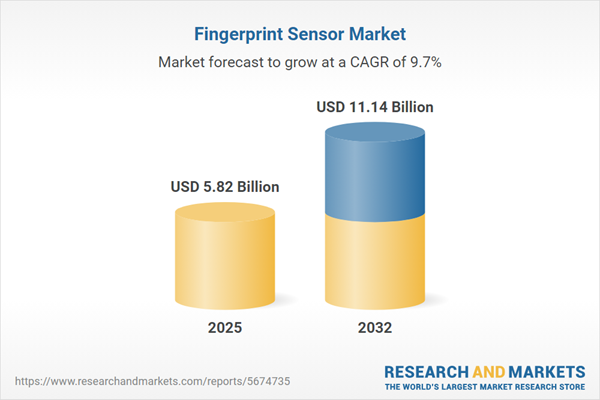Speak directly to the analyst to clarify any post sales queries you may have.
The fingerprint sensor market is evolving rapidly as organizations seek stronger security, streamlined identity management, and operational compliance amid changing regulations. Senior decision-makers are embracing advanced fingerprint sensor solutions to enhance digital authentication protocols and build resilient access control strategies.
Market Snapshot: Fingerprint Sensor Market Overview
The global fingerprint sensor market is poised for significant expansion, with its value projected to rise from USD 5.30 billion in 2024 to USD 5.82 billion in 2025, reaching USD 11.14 billion by 2032. This reflects a robust compound annual growth rate (CAGR) of 9.72%, highlighting increasing enterprise integration of biometric authentication systems. Technology, finance, healthcare, and automotive enterprises continue investing in fingerprint sensors to advance digital access and responsiveness to security requirements. Market investments are driven by the need for effective risk management and alignment with continuously evolving regulatory standards.
Scope & Segmentation: Fingerprint Sensor Market
This report provides in-depth segmentation specifically for executives steering technology initiatives and aligning fingerprint sensor approaches with their business imperatives. Each segment addresses compliance, operational effectiveness, and market-specific deployment strategies for targeted decision-making.
- Applications: Secure enterprise access, employee attendance tracking, automotive entry and ignition systems, device security endpoints, integration with mobile platforms, and accurate identification in healthcare enable organizations to enhance security and operational control.
- Technologies: Capacitive fingerprint sensors deliver high recognition accuracy, optical imaging sensors use LEDs for enhanced data capture, thermal sensors operate across temperature variances, and ultrasonic options support complex or specialized access points.
- Products: Modular and standalone sensors permit flexible customization for healthcare, automotive, and cross-industry use cases, empowering businesses to adapt implementation to their unique environments.
- Form Factors: Touch-based and contactless designs support both under-display and surface mounting, facilitating improved hygiene and user experience across remote and on-premises settings.
- Geographic Coverage: Report covers the Americas, Europe, Middle East, Africa, and Asia-Pacific, offering granular insights into regional markets such as China, India, Japan, Australia, South Korea, Indonesia, Thailand, Malaysia, Singapore, and Taiwan to support informed regional planning.
- Leading Companies: Comprehensive analysis of providers including Goodix Technology Inc., Fingerprint Cards AB, Synaptics Incorporated, Qualcomm Incorporated, Egis Technology Inc., IDEX Biometrics ASA, Next Biometrics Group ASA, Suprema Inc., Nitgen Co., Ltd., and HID Global Corporation explores their partnership models and business strategies.
Detailed segmentation supports leaders in optimal resource allocation, expeditious compliance fulfillment, and flexible adaptation of fingerprint sensor projects to unique sector and regional demands.
Key Takeaways for Senior Decision-Makers
- Machine learning capabilities embedded in fingerprint sensors raise authentication reliability and help organizations adapt seamlessly to shifting regulatory environments.
- Fingerprint sensor technologies integrate digital and physical access controls, accelerating modernization across highly regulated industries.
- Enterprise-focused sensor portfolios allow tailored deployments to fit specific infrastructure, risk exposure, and security policies.
- Collaborative partnerships in the supplier ecosystem expedite deployments while addressing sector-specific implementation challenges.
- Distinctive regional adoption strategies are crucial, with Asia-Pacific characterized by widespread implementation and EMEA emphasizing compliance with local standards.
- Advancements in contactless and under-display biometric solutions contribute to improved workplace hygiene and continuity for organizations managing hybrid and remote teams.
Tariff Impact and Global Supply Chain Dynamics
Recent U.S. tariffs have influenced fingerprint sensor manufacturers to reinforce regional supply chains and enhance local production capacities. Organizations now benefit from improved sourcing continuity and stronger procurement strategies, adapting quickly to changes in international trade conditions.
Methodology & Data Sources
This research synthesizes executive interviews, rigorous assessments of technical standards and patents, and analysis of prominent white papers. This multifaceted approach delivers actionable intelligence for high-level decision-making and market forecasting.
Why This Report Matters
- Risk and security leaders can fine-tune identity management and compliance frameworks in alignment with current biometric trends.
- Procurement teams can bolster supply chain resilience and reduce risks associated with shifting global trade environments.
- Competitive and regional insights support adaptive positioning and strategic compliance across established and emerging markets.
Conclusion
Fingerprint sensor technologies equip organizations to fortify access control and identity management systems. Strategic adoption supports business continuity and responsiveness amid ongoing regulatory change.
Additional Product Information:
- Purchase of this report includes 1 year online access with quarterly updates.
- This report can be updated on request. Please contact our Customer Experience team using the Ask a Question widget on our website.
Table of Contents
3. Executive Summary
4. Market Overview
7. Cumulative Impact of Artificial Intelligence 2025
Companies Mentioned
The companies profiled in this Fingerprint Sensor market report include:- Goodix Technology Inc.
- Fingerprint Cards AB
- Synaptics Incorporated
- Qualcomm Incorporated
- Egis Technology Inc.
- IDEX Biometrics ASA
- Next Biometrics Group ASA
- Suprema Inc.
- Nitgen Co., Ltd.
- HID Global Corporation
Table Information
| Report Attribute | Details |
|---|---|
| No. of Pages | 180 |
| Published | October 2025 |
| Forecast Period | 2025 - 2032 |
| Estimated Market Value ( USD | $ 5.82 Billion |
| Forecasted Market Value ( USD | $ 11.14 Billion |
| Compound Annual Growth Rate | 9.7% |
| Regions Covered | Global |
| No. of Companies Mentioned | 11 |








